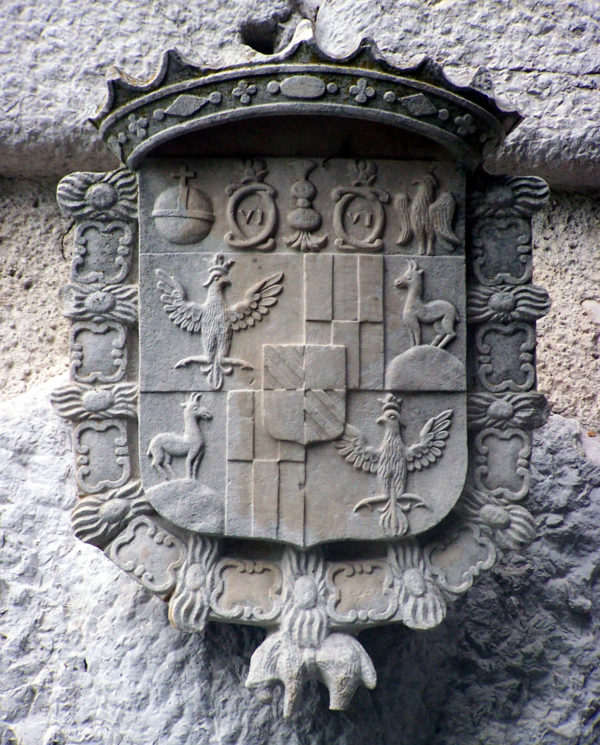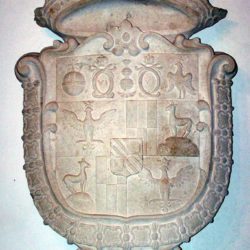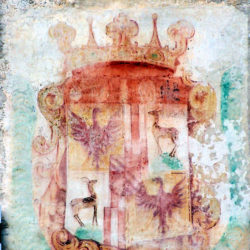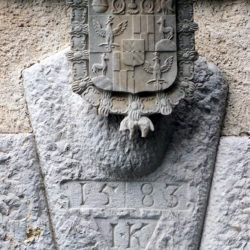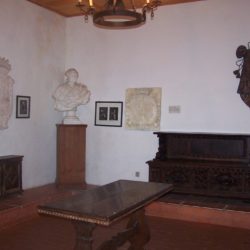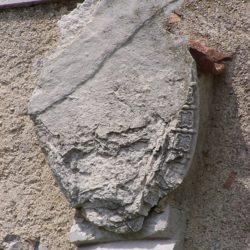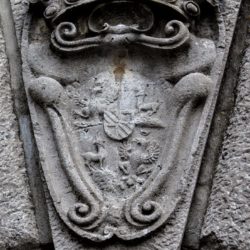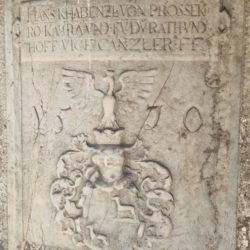
Coats of arms of the Cobenzl family in Predjama Castle
PREDJAMA, CASTLE
Location of the coat of arms: portal
The noble family most closely associated with Predjama Castle throughout its long history was undoubtedly the Counts Cobenzl, who served as its castellans for nearly 250 years—starting in 1567, when Johann Cobenzl took the castle and the seigniory in pledge and purchased them two decades later as a freeholding, and ending in 1810, after the family became extinct in its male line with the death of Johann Philip Count von Cobenzl. Over the course of these two and a half centuries, the Cobenzls carried out many reconstructions of the castle building, thus leaving the strongest mark on its appearance. Testifying to their long-term ownership of the castle are, among other things, as many as three heraldic depictions of their coat of arms, which are displayed within and outside the castle building. The modern visitor is first greeted by the Cobenzls’ large colored coat of arms, painted on the exterior of the three-story palacio. The second coat of arms is carved above the castle entrance, and the third, likewise made of stone, hangs on the wall of one of the castle rooms, in the company of the stone arms of the Coronini family and the copper arms of the Princes von Windisch-Grätz.
Between the sixteenth and eighteenth centuries, the Cobenzl coat of arms underwent a series of modifications and improvements, most notably in 1588, when Hans Cobenzl, Commander of the Teutonic Order, was raised to the rank of baron. On that occasion, the family’s coat of arms incorporated a heart shield, which is, in fact, the coat of arms of the Lords of Lueg, family relations to the Cobenzls—that is, Johann’s mother Anna descended from the Lueg family. The last and final version of the Cobenzl coat of arms is its stone depiction, now displayed above the castle entrance. Of particular interest is the heraldic chief (Germ. Schildhaupt) featuring a sovereign’s orb, a cup, and a falcon—symbols representing the Cobenzls’ hereditary honorary offices: the hereditary office of provincial pantler in Gorizia (since 1698), the hereditary office of provincial cupbearer in Carniola, and the hereditary office of provincial falcon master in Gorizia (both since 1719).
Both stone coats of arms in Predjama Castle are encircled by the chain of the Order of the Golden Fleece. Rather than being a component part of the coats of arms, the chain informs the visitor that its owner was also a knight of the aforementioned order. Moreover, because the family counted quite a few knights of the Order of the Golden Fleece, it is not entirely clear which Cobenzl had the heraldic plaque installed above the entrance. What leaves no doubt is that it was not Hans Cobenzl, whose initials I[oannes] K[obenzl] and the year 1583 are carved in the gable of the entrance portal below the heraldic plaque. Perhaps Hans’s heraldic plaque had once occupied the same place until one of his successors replaced it with his own, along with an improved coat of arms. Interestingly, neither the Coroninis nor the Windisch-Grätzes as the subsequent owners of the castle replaced this coat of arms with their own, but rather left it above the castle entrance, where it has remained intact to the present day.
Similar conclusions as for both stone heraldic plaques may also be drawn for the painted coat of arms on the castle’s external wall. The depiction of the coat of arms is much more recent than the year 1570 displayed above it. The Cobenzls were not even barons then, as was also reflected in their coat of arms’ simpler design. It most certainly did not have the chief, which was most probably introduced with the last improvement in 1722, when the Cobenzls already held three hereditary offices. In the location of this coat of arms, too, there was probably an older coat of arms painted and subsequently painted over by the more recent and final variant.
In relation to the final image of the coat of arms, mention also ought to be made of the somewhat mysterious letters VI between the two Cs in the second and fourth fields of the chief. That is, both letters appear in all three coats of arms of the Cobenzls in Predjama, but not in the blazons. Because Holy Roman Emperor Charles VI improved the Cobenzl coat of arms with a chief, the letter C probably stands for Carolus, and the letters VI represent the emperor’s regnal number.
Sources:
I Cobenzl; una famiglia europea tra politica, arte e diplomazia (1508-1823) (eds. Federico Vidic & Alessio Stasi). Roma: Lithos ; Gorizia: Archivio di Stato di Gorizia, 2022.
Sapač, Igor: Grajske stavbe v osrednji Sloveniji – III. Notranjska. Med Planino, Postojno in Senožečami. Ljubljana: Viharnik, 2005, pp. 44-67.
Stopar, Ivan: Predjamski grad. Postojna: Postojnska jama, 2001.
Die Grafen von Cobenzel. Beyträge zur Wappen- und Geschlechtskunde sämmtlicher Herrenstands-Familien des Österreichischen Kaiserstaats. Vienna: Anton Strauss, 1818.
